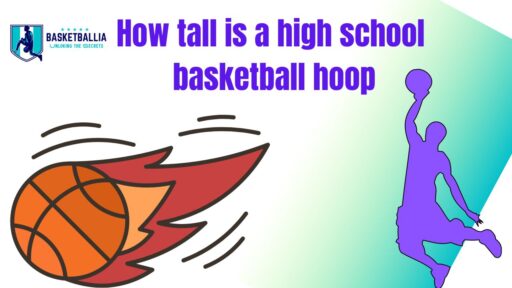Explore the official height of How tall is a high school basketball hoop and understand its significance in the game. Perfect for players, coaches, and basketball enthusiasts.
Get Ready to Dunk: How Tall is a High School Basketball Hoop?
Introduction to How tall is a high school basketball hoop
As an avid basketball enthusiast, I’ve always been fascinated by the intricacies of the game, especially when it comes to the equipment and regulations that govern it. One of the most crucial elements of the sport is the basketball hoop, and in this article, we’ll explore the standard height of a high school basketball hoop and how it impacts the game.
High school basketball is a beloved pastime for many young athletes, offering them the opportunity to showcase their skills, compete against their peers, and develop a deeper appreciation for the sport. Whether you’re a player, a coach, or a passionate fan, understanding the regulations and specifications surrounding the basketball hoop is essential to fully appreciate the game.
Basketball Hoop Height by Age
The height of a basketball hoop can vary depending on the age and level of play. Here’s a quick overview of the standard hoop heights for different age groups:
Age GroupHoop Height
Elementary School 8-9 feet
Middle School 10 feet
High School 10 feet
College 10 feet
Professional (NBA) 10 feet
As you can see, the hoop height remains consistent at 10 feet for high school, college basketball, and professional basketball. This standardization ensures a level playing field and allows players to develop their skills and techniques accordingly.
The Standard Height of a High School Basketball Hoop
The standard height of a high school basketball hoop is 10 feet (3.05 meters) from the floor to the rim. This regulation has been in place since the early days of the sport and has remained unchanged over the years.
The 10-foot hoop height was initially established by the inventor of basketball, James Naismith, in 1891. He chose this height based on the available gymnasium equipment at the time and the need to create a challenging yet achievable goal for players.
History and Evolution of Basketball Hoop Heights
The history of basketball hoop heights is fascinating, with the standard 10-foot height remaining a constant throughout the sport’s evolution.
In the early days of basketball, the hoops were often improvised, with peach baskets or other receptacles being used as the goal. As the sport grew in popularity, the need for standardized equipment became evident, and the 10-foot hoop height was established.
Over the years, there have been occasional experiments with different hoop heights, such as lowering the rim to 9 feet or raising it to 11 feet. However, these variations never gained widespread acceptance, and the 10-foot standard has remained the norm.
The Impact of Hoop Height on the Game
The height of the basketball hoop has a significant impact on the game, influencing the strategies, skills, and overall dynamics of play.
At the high school level, the 10-foot hoop height presents a unique challenge for players. Compared to younger age groups with lower hoops, high school players must develop a higher vertical leap, better shooting mechanics, and more precise ball handling to effectively score and compete.
This standard hoop height also shapes the style of play, encouraging more outside shooting, perimeter-oriented strategies, and a greater emphasis on athleticism and agility. Dunking, a crowd-pleasing feat, has become a more accessible and coveted skill for high school players.
How Many Feet is a High School Basketball Hoop?
As mentioned earlier, the standard height of a high school basketball hoop is 10 feet (3.05 meters) from the floor to the rim. This measurement has remained consistent across the sport, ensuring a level playing field and allowing players to develop their skills accordingly.
How Tall are NBA Hoops?
The height of the basketball hoop in the NBA is also set at 10 feet (3.05 meters) from the floor to the rim. This standard has been in place since the league’s inception and is the same as the regulation height for high school and college basketball.
The consistent hoop height across different levels of play allows players to seamlessly transition between the various leagues and maintain their skills and techniques. It also ensures that the game remains fundamentally the same, regardless of the age or level of the players.
How Tall is a High School Basketball Hoop in Feet?
To reiterate, the standard height of a high school basketball hoop is 10 feet (3.05 meters) from the floor to the rim. This measurement has been the norm for the sport since its early days and has remained unchanged over the decades.
Factors to Consider When Determining Hoop Height
While the standard 10-foot hoop height is the norm for high school basketball, there are a few factors that can influence the actual height of the hoop in a specific setting:
- Venue Specifications: The dimensions and layout of the basketball court, as well as the available space in the gymnasium, can sometimes necessitate slight adjustments to the hoop height.
- Safety Considerations: In some cases, the hoop height may be lowered slightly to accommodate younger or shorter players, ensuring their safety and preventing potential injuries.
- Player Skill Level: In certain training or developmental settings, the hoop height may be adjusted to better suit the skill level of the players, allowing them to practice and improve their shooting and dunking abilities.
- Equipment Limitations: The physical characteristics and design of the basketball hoop itself can also play a role in the final height, as some systems may have limited adjustability or fixed mounting points.
The Importance of Regulation Hoop Heights in High School Basketball
The consistent 10-foot hoop height in high school basketball serves a crucial purpose in the sport. It ensures a level playing field, allowing players to develop their skills and techniques without having to adapt to varying hoop heights.
This standardization also facilitates the seamless transition of players between different levels of competition, from middle school to high school to college. By maintaining the same hoop height, players can carry over their skills and experience, leading to a more cohesive and competitive basketball ecosystem.
Furthermore, the regulation of hoop height plays a vital role in the development and training of high school players. It challenges them to improve their vertical leap, shooting accuracy, and ball-handling abilities, ultimately producing well-rounded and skilled athletes.
Common Misconceptions about High School Basketball Hoop Heights
Despite the well-established 10-foot hoop height standard, there are a few common misconceptions that persist among some basketball enthusiasts:
- Varying Hoop Heights: Some people believe that high school basketball hoops can vary in height, with some being slightly taller or shorter than the regulation 10 feet. However, this is not the case, as the 10-foot height is the universal standard across high school basketball.
- Adjustable Hoop Heights: Another misconception is that high school basketball hoops are adjustable, allowing for changes in height. While some specialized training or developmental setups may feature adjustable hoops, the vast majority of high school basketball courts have fixed, non-adjustable hoop heights.
- Differences Between Levels: Some individuals may think that the hoop height varies between high school, college, and professional basketball. However, as mentioned earlier, the 10-foot hoop height is consistent across all these levels, ensuring a seamless transition for players.
Addressing these misconceptions can help players, coaches, and fans better understand the regulations and specifications that govern high school basketball, leading to a more informed and appreciative experience of the game.
Training and Techniques for Dunking on Regulation-Height Hoops
Dunking, the impressive feat of a player elevating and placing the ball through the hoop, is a highly sought-after skill in high school basketball. While the 10-foot hoop height presents a challenge, there are various training techniques and strategies that players can employ to develop their dunking abilities.
One key aspect of dunking on regulation-height hoops is improving vertical jump. High school players can engage in plyometric exercises, strength training, and targeted jump-focused drills to enhance their explosive power and vertical leap. This, in turn, allows them to clear the 10-foot rim more easily and execute successful dunks more easily.
Additionally, players can work on their ball-handling, body control, and timing to better position themselves for effective dunks. Incorporating these skills into their overall game plan can help high school players become more versatile and dynamic on the court.
Safety Considerations When Dunking on High School Basketball Hoops
While dunking on a 10-foot hoop can be an exhilarating and crowd-pleasing feat, it’s essential to consider the safety aspects involved. High school players should always prioritize their well-being and take the necessary precautions to prevent injuries when attempting to dunk.
Some key safety considerations include:
- Proper landing technique: Emphasizing a controlled and balanced landing to avoid knee, ankle, or back injuries.
- Supervision and spotting: Having coaches or trained personnel present to assist and monitor dunking drills and practice sessions.
- Protective equipment: Utilizing padding, mats, or other safety gear to cushion any potential falls or collisions.
- Skill-appropriate progression: Gradually build up to dunking by mastering the necessary vertical leap, body control, and landing skills.
By prioritizing safety and following best practices, high school basketball players can develop their dunking abilities while minimizing the risk of harm.
Conclusion of How tall is a high school basketball hoop and Final Thoughts
In the world of high school basketball, the 10-foot hoop height is a fundamental aspect of the game that has stood the test of time. This consistent standard ensures a level playing field, challenges players to develop their skills, and fosters a seamless transition between different levels of competition.
As we’ve explored in this article, the history, impact, and considerations surrounding the high school basketball hoop height are fascinating and multifaceted. By understanding these nuances, players, coaches, and fans can gain a deeper appreciation for the sport and the role that equipment regulations play in shaping the game.
Whether you’re a high school basketball player looking to improve your dunking abilities or a fan eager to learn more about the sport, I encourage you to continue exploring the world of basketball hoops and regulations. Stay tuned for more insightful articles on the technical aspects of the game that can enhance your understanding and enjoyment of this beloved pastime.








